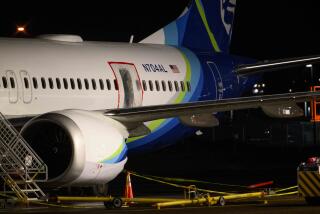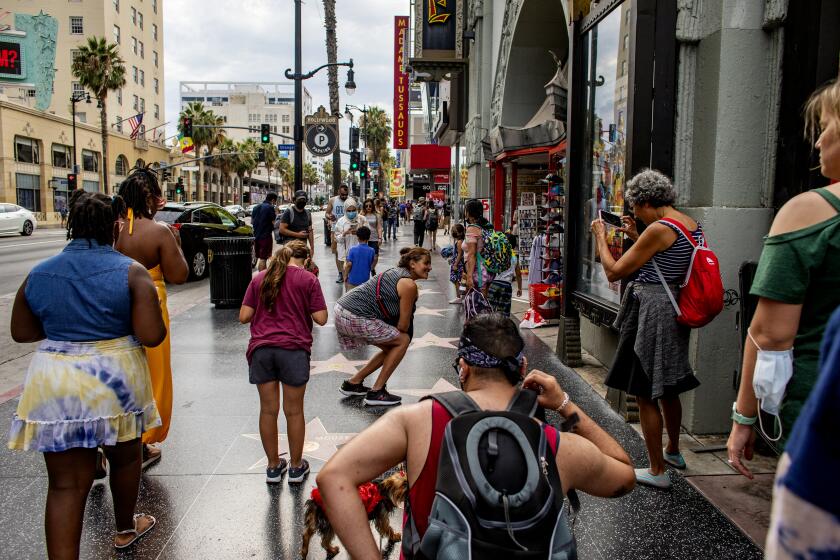Crash Creates Void at Top of Several Firms
The crash of Commerce Secretary Ronald H. Brown’s plane Wednesday in Croatia represents the nation’s largest loss of top-level executive talent in a single tragedy, leaving a void at several companies, including Parsons Corp., the venerable Pasadena construction and engineering firm.
A dozen executives from the telecommunications, banking and construction sectors--three of them from California--were among those traveling with Brown to offer expertise, products and services to help the war-ravaged former Yugoslavia begin rebuilding. Their presumed loss cast a pall over the business world and especially over employees at the affected companies, many of whom a day earlier had been upbeat at the prospect of landing business in the struggling region.
At Parsons, employees were in shock as they awaited news about their chief executive officer, Leonard J. Pieroni, 57. Officials of Guardian Industries Corp. in Auburn Hills, Mich., were behind closed doors much of the day as they absorbed the potential loss of David Ford, a senior executive who had planned to donate 23 metric tons of glass to Sarajevo for windows in new office and apartment buildings.
The tragedy spotlighted the need for succession planning and the risks inherent in executives’ traveling into remote and politically unstable corners of the world as they reach for business in today’s increasingly global marketplace.
“The reality is, executives do have to fly together, and sometimes these things happen,” said Jack Groban, managing director of A.T. Kearney, an executive search firm in Los Angeles. Most corporations, he and other experts said, do a poor job of planning to cope with such loss.
As in past cases of such corporate loss--affecting companies from Donald Trump’s gambling and real estate empire to Walt Disney Co. to In-N-Out Burgers to Chevron Corp.--there will undoubtedly be a flurry of activity as companies attempt to prepare for tragic eventualities. But once the shock phase has passed, Groban said, companies will return to their old ways.
Bechtel Corp., the big San Francisco engineering firm, confirmed that one of its executives was scheduled to be on the plane. P. Stuart Tholan, 59, was president of Bechtel Europe, Africa, Middle East, Southwest Asia, a unit with oversight of company markets throughout the region. Based in London, the Philadelphia native had been with Bechtel 33 years. He oversaw the company’s monumental work in reconstructing Kuwait’s oil production facilities after the Gulf War.
Another California executive on board was Ian Donald Terner, 56, founder and president of Bridge Housing Corp., a nonprofit builder of low-income housing based in San Francisco.
One executive reacted to the news with an awkward mix of relief and sadness. Told of the crash at a gathering in Fairfax, Va., that he had chosen to attend instead of accompanying Brown, Daniel R. Bannister became ashen. He pulled out a dog-eared itinerary for the trip that still happened to be in his breast pocket and fingered it nervously.
Bannister, the CEO of DynCorp Inc., a high-technology services company, was among 15 U.S. executives Brown had invited to accompany him on the trade mission to Bosnia and Croatia, but Bannister canceled at the last minute. Three other executives, including Alfred Checchi, co-chairman of Northwest Airlines, did not board the ill-fated plane.
“I am obviously grateful I didn’t make the trip,” Bannister, 67, said in a stunned monotone. “I deeply regret what has happened.”
News of the crash shocked the business community, which gave Brown high marks for his efforts to promote U.S. industry. AT&T; Corp. Chairman Robert E. Allen said he has accompanied Brown on trade missions overseas “and I know first hand how much he helped open doors for the business community.”
John E. Bryson, chairman of Rosemead-based Edison International, who went to China with Brown, said: “Brown’s efforts to promote America’s business interests in the international marketplace were unparalleled.”
This time it was a headline-grabbing crash that drove home the need for businesses to think about succession planning. A heart attack, a traffic accident or an act of violence can rob an organization of its leaders.
After Frank G. Wells, Disney’s president, died in a helicopter crash while on a ski trip in April 1994, CEO Michael Eisner took on his responsibilities. Entertainment industry observers contended that the added burden might have contributed to Eisner’s need for emergency heart surgery a few months later. While on his hospital bed, a chastened Eisner reportedly began composing a list of possible successors.
After a 1991 plane crash in Malaysia killed four senior Conoco Inc. executives, the company saw remarkably little disruption because the Dallas-based oil company had a succession plan in place.
Irvine-based In-N-Out Burgers lost its president, Richard A. Snyder, when his small plane crashed in a Santa Ana field in late 1993. Snyder, son of the company’s founders, was only 41 but had made plans for such an event.
Snyder’s mother, Esther, quickly stepped back to the helm of the family-owned company and his older brother, Guy, was chosen for a newly created chairman’s position.
But such foresight is unusual, particularly among small and family-owned companies where the task can be made more complex and emotional by deep ties and old grudges.
Among large companies, a startling 37% do not have a succession plan, according to a 1994 study by Korn/Ferry International, a leading executive search firm. Two-thirds of those that do have a plan have not identified a successor.
“It’s just very difficult for some senior managers to face the reality that other people will be moving forward in the company,” said Caroline W. Nahas, managing vice president of Korn/Ferry in Los Angeles.
Eric G. Flamholtz, a UCLA business professor and president of Management Systems Consulting, a Westwood firm that helps companies with succession planning, said, “The only thing companies tend to do to minimize . . . this situation is to avoid having a number of senior executives flying on the same plane.”
At General Motors Corp., for example, Chairman John Smith and Vice Chairman Harry Pearce do not fly on the same plane. No more than half of the key managers of any one executive group at the auto company can fly together.
GM also seeks advice from outside security consultants about flying executives over areas of the world that are considered risky.
Hewlett-Packard Co. forbids travel on the same aircraft by more than half its corporate board, half its management council, three organizational vice presidents and 28 company employees.
The company also tries to avoid flying CEO Lewis Platt on the same plane with the company’s chief financial officer, said Earl Foster, Hewlett-Packard’s corporate travel manager, who also is president of the Assn. of Corporate Travel Executives.
Despite such a policy, Chevron Corp., the San Francisco oil giant, suffered a stunning loss in 1987. The president and three other managers of Chevron USA perished after a disgruntled airline employee smuggled a gun on board a PSA flight and killed the pilot. The plane crashed, killing everyone aboard.
Will Price, who succeeded James R. Sylla as Chevron USA president, said he dealt with “equal measures of grief and shock [over] the bizarre, unimaginable event.” It took the company 10 days to name him as successor, but in the meantime, he said, people pulled together “to keep the organization calm and focused.”
Price, who retired in 1990, said Chevron has a very sophisticated succession planning process. “There is no indispensable individual,” he said. “You have to have a plan.”
Runzheimer International, a benefits consulting firm in Rochester, Wis., reports that 26% of companies surveyed limit traveling together by senior management and 15% limit such travel at all levels. But that leaves nearly 60% of companies that do not address the issue.
Some companies without restrictive travel policies have learned the hard way. In December 1991, six executives of the Bruno’s chain, which runs Piggly Wiggly markets in Southern states, were killed when their corporate jet crashed near Rome, Ga. The dead included company founders Angelo and Lee Bruno.
Donald Trump’s real estate empire was thrown into turmoil after a 1989 helicopter crash killed three key executives. On the flight were the head of Trump’s Atlantic City casino operations, the head of the Trump Taj Mahal hotel and the vice president of the Trump Plaza hotel.
Security consultants geared to preventing kidnappings or terrorist attacks agreed that little can be done when it comes to a foul-weather plane crash like the one that claimed Brown’s entourage.
“If a plane goes down for weather or technical reasons, there’s not much you can do,” said Chris Marquet, managing director of New York-based Kroll Associates, a security and risk-management company.
Special correspondent Karen Kaplan and Times wire services contributed to this story.







